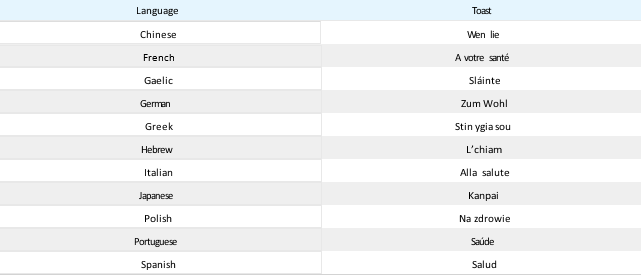Learning Objectives
Discuss the role, function, and importance of a toast.
Discuss the elements of an effective toast.
Toasts are formal expressions of goodwill, appreciation, or calls for group attention to an issue or person in a public setting. They are often followed by synchronous consumption of beverages. Examples include toasts at weddings to congratulate the couple, toasts at a bar after a tournament win to congratulate the team or an individual player, or general toasts to health for everyone on a holiday or other special occasion.
Toasts serve to unify the group, acknowledge a person or event, mark a special occasion, or simply encourage alcohol consumption. These can range from serious to silly but are normally words that point out something that is commonly known. For example, a toast to the most valuable player in a game may publicly acknowledge him or her for achievements already known by the community. The verbal recognition, followed by ritualistic drinking, serves as a public acknowledgment. Belonging is a basic human need that requires reinforcement, and a toast can be characterized as a reinforcement ritual, acknowledging respect for the individual or team and reinforcing group affiliation, common symbols, terms, beliefs, values, goals, and aspirations (McLean, S., 2005).
While common in many societies, toasts are relatively rare in daily life. They are normally associated with informal and formal group, team, or community gatherings. Since you may only perform a couple of toasts in your lifetime, you no doubt want to get them right the first time. We will address toasts and one variation, in particular, the roast.
Proposing a Toast
One proposes a toast rather than “making” a toast or simply “toasting” because for it to truly be a toast, everyone in the group, team, or community must participate. If you propose a toast to someone and no one responds, even if you raise your glass to them as a nonverbal sign of respect and take a sip, it doesn’t count as a toast. Only the community can publicly acknowledge someone with a toast, but it takes an individual to make the proposition.
Sometimes, the person who is supposed to make that proposition is already known by function or role. The best man and maid of honor at a wedding, the host of a party, and the highest-ranking manager at a business meal are common roles associated with ritualistic toasts.

Standing with proper posture to address the group is normally associated with acts of public speaking, including toasts. If you are understood to be a person who will be proposing a toast, you may not need to say anything to get the group’s attention. As you rise and raise your glass, the room will grow quiet in anticipation of your words. If the group does not expect you to propose a toast, you may need to say, “May I propose a toast?” in a voice above the level of the group. Nonverbal displays also work to capture attention (McLean, S., 2005), such as standing on a chair. While that may be nonstandard, your context will give you clues about how best to focus attention. Striking a glass with spoon to produce a ring, while common, is sometimes considered less than educated and a poor reflection of etiquette. The group norms determine what is expected and accepted, and it may be a custom that is considered normal. Etiquette is a conventional social custom or rule for behavior, but social customs and rules for behavior vary across communities and cultures.
You will raise your glass, raise your voice, and compliment the honored person. Your toast should be brief. If you write it out in advance, use thirty words as your upper limit. Common mistakes are for toast-givers to ramble on too long and to talk about themselves instead of the honoree. The toast is not as much about the words you use, though they carry weight and importance; it’s about the toasting ritual as a group expression of acknowledgment and respect. People then raise their glasses to indicate agreement, often repeating “hear, hear!” or a word or phrase from the toast, such as “to success!” They then sip from their cup, possibly touching glasses first.
One common toast that always unifies the group is the toast to health. Proposing a toast to health is common and well-understood, and it serves a toast’s role and function. “Live long and prosper” is a common variation of “to your health” in English. Table 15.4.1 lists toasts to health in other languages.

Sometimes, a best man at a wedding will be expected to tell a short story as part of their toast. A common story is how the couple met from the best man’s perspective. While this may be your choice, remember to keep it brief, positive, and focused on the honorees, not yourself. Important occasions require you to play your part like everyone else, and your role is to focus on the individual, team, couple, or group as you honor them.
Alcohol is neither required for a toast nor draining one’s glass. The beverage and the quantity to be swallowed reflect group norms and customs. Often, alternatives, such as nonalcoholic sparkling cider, are served. If you are expected to perform a toast that requires tact, grace, and a clear presence of mind, you should refrain from drinking alcohol until after you’ve completed your obligation. Your role has responsibilities, and you have a duty to perform.
Roasts
Roasts are public proclamations that ridicule or criticize someone to honor them. While this may sound awkward initially, consider the targets most commonly associated with roasts: those in positions of power or prestige. Knocking someone off their pedestal is a special delight for the group or community, but it requires special care and attention to social dynamics, sensitivities, rank, and roles.
A common context for a round of roasts, or a series of public statements intended to poke fun at someone, is at a retirement party. Individuals in the room tell brief stories that may have some basis in truth, but through word choice and clear communication of exaggeration, everyone can look back upon the episode with light humor and laughter. Time has passed, and the absurd is worthy of group laughter.
A roast is not an opportunity to say something mean. If you don’t think the target will laugh it off, don’t say it. Roasts can hurt feelings, and that misses the point. A roast honors someone in a position of power or influence by allowing them to demonstrate they can take a joke gracefully at their own expense. It is not intended to harm the individual or create divisions in the community. Ritual public speaking is supposed to unify groups, teams, and communities and not create division or rival internal groups.
Key Takeaway
Toasts and roasts honor a member of the community.
Exercises
You are called upon to propose a toast to your team leader after your group has just completed a large contract. Work on this project wasn’t always easy, but now is the time for celebration and recognition. Write a sample toast in no more than thirty words. Compare your results with your classmates.
What should someone propose a toast to? How should they propose it? Write your response and include an example. Compare with classmates.
If you were the subject of a roast, what would you feel comfortable having people say, do, or show to make fun of you in public? Write your response and include an example. Compare with classmates.
McLean, S. (2005). The basics of interpersonal communication. Boston, MA: Allyn & Bacon.
This page titled 15.4: Celebrations – Toasts and Roasts is shared under a CC BY-NC-SA 3.0 license and was authored, remixed, and/or curated by Anonymous (LibreTexts Staff), from which source content was edited to the style and standards of the Pressbook platform licensed under a Creative Commons Attribution-NonCommercial-ShareAlike 4.0 International License by Brandi Schur.

